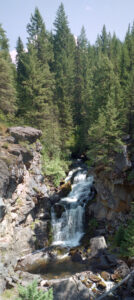Our eastbound trek begins in Sedro Woolley, Washington (we never asked why the town had such a weird name). From here, the Cascades are snowy peaks on the distant eastern horizon. For a couple of hours we passed land producing apples and berries as we watched the peaks get closer. The fruit trees eventually gave way to evergreens, and the valleys gave way to hills which became mountains. We also started to notice an uptick in motorcycle traffic, which continued to increase as we went east.
As we entered the National Forest we noticed a high-capacity power line shadowing our road. The drive through North Cascades National Park passed along the shores of three large lakes, each in existence due to a massive hydroelectric dam built long ago to keep the lights on in Seattle. The raging rivers thundering down the canyons are gone, replaced by long sections of dry riverbed where the river had been diverted into a big pipe feeding the turbines further down the mountain. All that remains to “cascade” are the smaller streams spilling into the canyons from the side.
The snow-covered peaks rising above the sharply-angled slopes make the Cascades one of the most picturesque ranges that we saw on this oddyzee. Driving through the pass, we experienced the contrast between the wet and dry sides of the range. The slopes facing the ocean are true temperate rain forests, and they see more rain than almost any place in North America. But the rains cannot get around the mountains, leaving the other side dry and the land beyond it in a “rain shadow”. This slope still had rugged country, but sparsely scattered trees and grassy meadows had replaced the lush moss of the rain forest. It looked like the Ponderosa, and we half-expected one of the Cartwright boys to come riding up on his horse to greet us.
In spite of our proximity to the Canadian border, we were on a desert that looked much more like Arizona than what we expected Washington to be. Only in the high elevations (6000+ feet) did we see the density of trees that we associate with forests. We saw one area that had experienced a severe fire in 1991. It was in one of forested areas that we had a fantastic wildlife sighting right around dusk. A mother moose and her calf crossed the road about 50 yards in front of us. It was our second moose sighting of the oddyzee, and our first since Colorado (six weeks ago).
Just before stopping for the night in Kettle Falls, Washington, we crossed the Columbia River one last time. We had last crossed it at its mouth, all the way back in the opposite corner of the state. This far upstream it is still a wide river in a deep gorge fed by the mountains of British Columbia, and it is already powerful enough to drive turbines that power air conditioners throughout the West.


